Step-by-Step Tree Planting Tips:
Your fruit trees will be here, labeled, sorted and ready for pickup Friday/Saturday/Sunday April 6/7/8, 2023. They will have already been pre-pruned by VanWell Nursery before we pick them up. In addition, we cut off any broken branches and any broken roots to make your planting experience more successful.
Pick up times: Feel free to come between 8am – 5pm on Saturday or 9am – 3pm Sunday.
We’d like all the trees picked up by Sunday at 3pm so that they can get into the ground as soon as possible so they will be less-stressed.
We want your trees to thrive, so here are some tips and tricks we’ve found that worked for us. . .
Planting: Please dig your holes as soon as you can, so you can just pop your trees right into the ground. Ideally, you will have those holes dug BEFORE you get your trees home. Dig holes twice as wide as the roots; about 14-16 inches or more. For clay soils, add two handfuls of gypsum granules (cheapest place to get it is Moscow Builders). Cut off any damaged spots on the roots.
You can soak your trees for up to 2-3 hours before planting. However, Do not ‘store’ your trees in a bucket of water as this will kill them. If you can’t plant your trees right away you can put them into a cool place, cover their roots with moist sawdust or peat moss or heel them into a soil berm. Keep the roots moist but not wet before you get them into the ground!
You can also plant them in large pots but you’ll have to water them 2-3x/week, every week through spring, summer and , fall. We often plant our baby trees in pots to allow them to grow a larger root system before planting them in the ground. Plant potted trees in the late fall after the first rains for best results.
Note: 70% of root growth happens in the fall-winter months. Planting/caring for fruit trees is a big job calling for about 7 months of watering/pampering… each year, until they are mature.
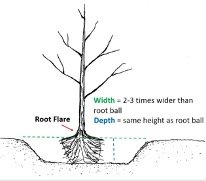
Set the tree to the same line as they were planted (the top of the root ball) before they were harvested (about 8 inches deep). One easy way to gauge this is to set a long stick on top of the ground next to the tree across the hole (for example, see the green line in the above picture—pretend it’s your stick) and raise the tree out of the hole until it’s level with the stick. It’s best done with two people.
If you plant your trees too deep and you have clay soil, water may fill the planting holes and your trees may drown (especially the cherry and other stone fruit trees). If you have soil like this dig some spokes out from the tree hole on the downward side so that water filling the hold can drain out. Fill the spike parts with lighter soil, compost, or bark then top it off with soil from the hole and surrounding area.
As the roots grow the ends will find those spokes and head out in that direction instead of circling on themselves to become root bound.
We build a berm around each tree large enough to hold 5-gallons of water. Van Well recommends to water with 5 gallons/week per ½ inch diameter of tree. Your trees are between ½ and ¾ in diameter.
Most fruit trees have been grafted. Set/position the bumpy part of the graft facing towards the windiest side of where you plant. See the photo with the pink paint on the tree trunk? Place that pink side facing the strongest wind.
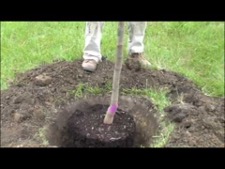
Before you put the tree into the hole: Inside the hole on the bottom, mound the dirt up in the center to support the bottom of the tree. The soil going into the hole should be a mixture of 60-80% of the soil you took out of the hole and the other 20–40% some kind of organic matter (compost/peat moss/potting soil).
Note: If you put too much compost into the hole, when the tree matures, it is likely to be blown or just fall over. Your trees should be staked for the first couple of years until the roots set. Winds have a tendency to bend them over if not staked.
Aside from adding gypsum to clay soil… do NOT put amendments (fertilizers, etc.) into the planting hole. Water thoroughly.
Mulching: Wait a couple of weeks and then you can put some amendments on top of the soil. Mulch with about 3-6 inches of your chosen organic matter out to about 4 feet diameter around each tree. Keep the mulch and amendments back a couple inches to protect the tree trunk from ‘burning’ and discourage mice from eating the bark. *That mulch holds moisture is a good thing. That it provides cover for mice and voles is not so good. Many growers install plastic protection around baby tree trunks and then, remove it when the tree is more mature.
We use rabbit manure, lawn clippings, fir cones, pine needles, leaves, “soiled” straw from the chicken house. We also use mulch from the WSU compost facility when it has passed the chemical test (Note that this year the sampling failed and there is too much chemical in it to put put onto food/vegetable gardens).
At last we heard, the compost from Latah Sanitation is not safe to use on plants grown for food. You actually have to sign a waiver to use it. We have used this free compost in the past ONLY on our roads for growing grass.
We tried using cardboard as mulch one year but the trees died because they couldn’t get enough water. This probably would have worked had we had the drip system set up under the cardboard but then you have to worry about mice chewing holes in your hoses.
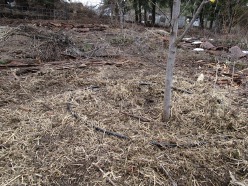
We plant many fruit trees inside our chicken pen. The dropped fruit is nutritious and free chicken food. However, chickens WILL scratch and unearth your tree roots if you don’t protect those roots. We put a barrier on the ground around the tree so the chickens can’t scratch the dirt up. We use old plastic fencing, broken rakes, wire fencing—whatever we have. We cut a hole in the center so as the tree grows it won’t rub against the trunk. Eventually we will remove the barrier but that will be years down the road.
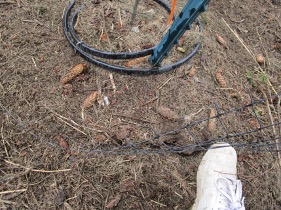
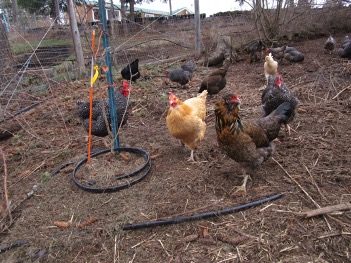
Drip Systems: After spending literally thousands of dollars trialing different types of drip systems we decided that the Perma-lock drip system from Drip Depot was the best stuff. The folks at Drip Depot are nice, very helpful and provide fast service. We make a nine foot long loop and encircle the tree with it. We can spread this loop of drip tubing out farther as the canopy of the tree gets larger so that the water will stay at the drip line of the tree.
TIP: You can lay unpainted sheet rock onto the area of the trees to soften/break up the soil. Cover the sheetrock with mulch. Make friends with a local contractor. They throw truckloads of the stuff away! Be a kind neighbor and cover up the eyesore though. It takes 2 years for sheetrock to break up. Every once in a while I pull off the paper layers sticking up and put them onto the compost pile. After 2 years you will have about 6-8 inches of loamy soil where the sheetrock dissolved as the cation activity of the gypsum breaks up the clay in the soil.
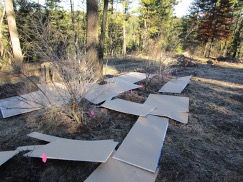
Watering: You will need to provide each tree with 5 gallons of water EACH WEEK for each ½ inch diameter trunk size. Your trees today are about ¾ inch (so that means about 7 gallons/week for best results).
Now here’s the hard part. Take off all but one or two of the apples for the first two years or the nourishment going to ripen the apples will take away from the nourishment the trunk needs which leads to a weaker tree and more disease.
Rodent prevention: We often plant a ring of garlic 2-3 inches apart and 6 inches from the trunk with another ring of daffodils about 16 inches from the trunk so that the mice/voles/rodents do not want to get in there to eat bark and roots in the fall. The mice/voles hate these plants. The garlic throws their scent off and the daffodils are toxic to them.
We’ve never lost a tree to rodent damage by doing this step. We rarely harvest the garlic. Be careful!! DO NOT eat the daffodils. They are very toxic to humans and will cause gut-wrenching vomiting and bleeding for days. If you can’t identify the garlic from their appearance and smell, then don’t take the risk!
Some people put hardware cloth or one of those white wrap-around protectors or a piece of black corrugated drain tile cut lengthwise around the trunk of the tree to help protect it from mice, as well as, from sun scald in winter. It is VERY important to remove those protections when the tree is more mature or it will grow into the trunk. Some growers say the white plastic wrap around the trees needs to be removed every spring as they have a tendency to harbor insects. That is a hassle when you have as many trees as we do so. . .
Sometimes we paint our trunks with ½ white latex paint mixed with ½ water for protection from sun scald. It lasts for a couple of years. Another way to work around the sun scald issue is to plant a fruit bearing shrub or nitrogen fixing plant on the southwest side of the tree. It will shade out the sun where it hits the trunk.
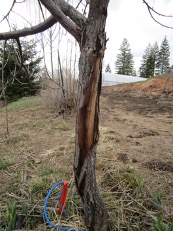 This peach tree had been painted but the paint wore off after two years. The sun hit the south size (left in the photo) and heated up the bark. The back side was cold. The split/damage occurs between the front and the back tree. If this were an apple we could probably do a bridge graft and repair it with a sucker we would attach to healthy tissue but this tree is a stone fruit and pretty much done for.
This peach tree had been painted but the paint wore off after two years. The sun hit the south size (left in the photo) and heated up the bark. The back side was cold. The split/damage occurs between the front and the back tree. If this were an apple we could probably do a bridge graft and repair it with a sucker we would attach to healthy tissue but this tree is a stone fruit and pretty much done for.
Spraying: We have never sprayed our trees with anything. Trying not to. Our goal for the farm is to see what grows here with as little fuss as possible. We should maybe spray with some dormant oil before the bugs break but our farm is so difficult to get around because it’s on a slope. I tried a back pack sprayer but it was too heavy for me to use.
Cheap Dormant Spray Recipe:
- 1 cup Oil (Olive or Canola or Vegetable oil)
- 2 Tbls Dish soap
- 1 gallon Water
The Stone Fruits (Apricot, Plum , Peach, Nectarine, Cherry): Our experience has been that when we plant these types of trees on the south or west facing parts of the property that they get heated up too early in the season and bloom too early. Most years we have a late frost which damages most of the blossoms, so we don’t get much fruit from those trees and it’s hard on the trunks (they split from the sun scald and get a brown gooey bacterial infection which kills them off).
We now plant these trees on the NORTH side of the farm and on Hugelkultures (mounds of logs/sticks/compost that have settled and rotted for about 3 years). Apricot/Peach/Nectarine trees were originally from the Mediterranean areas. They like good drainage and fertile soil. Their feet do not like to be very wet for any length of time.
Pruning Stone Fruit trees: I prune all our stone fruits in the summertime when it’s hot out and we are not expecting any rain. This way, the cuts dry out and scar quickly. Moist, rainy weather and pruning stone fruits do not mix. It carries bacteria into and under the bark (we lost a few trees because of this with our first planting in 2011).
Once a year I cut away all the D stuff (Damaged, Dead, Diseased, Dying, Deformed branches). Sometimes I will do heading cuts (lop off the longer branches so that they will branch out more the next year) and sometimes I do thinning cuts (removing crossed branches and to let light into the center of the trees like a vase).
The Peach and Nectarine trees don’t seem to last long but are prolific producers the first 2-3 years so you may not want to prune much off of them and you may not want to thin the fruit.
Pears: Plant your PEARS in areas where there are wet spots. Their roots can handle wet soil better than any of the other fruit trees.
Suckers on all fruit trees: Cut the root stock suckers off the base of every year or the suckers will draw too much energy away from the graft and eventually the graft will fail. This is more common for the cherry trees but the apple trees sucker fairly easily as well.
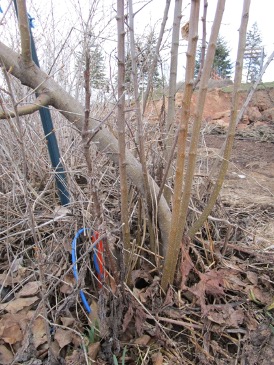 This apple tree was not staked in a timely manner. It started to sucker from the root stock and has not yet been pruned.
This apple tree was not staked in a timely manner. It started to sucker from the root stock and has not yet been pruned.
Aphids: This seems to be an issue when you don’t spray. Aphids show up around May. You’ll see some leaves start to curl on your trees. We’ve tried purchasing ladybugs but they just fly away. Currently we’re building habitat for them. We don’t want to spray to kill the aphids because in doing so, we will also kill the ladybugs and other insects!
When a tree is under aphid attack, it puts out a distress signal that the ladybugs smell, so they are on the way but they do need a bit of help or the aphids get out of control. To help out the ladybugs and not have to use spray, I get a 5-gallon bucket, fill it half way with hot soapy water and and a touch of bleach, then prune the tips of the trees affected by the aphids (they will be green or black bugs depending on the species).
I cram all those aphid-infested tips into the bucket, slosh them up and down a few times and keep packing the bucket with the infected greens. I give it a final slosh then leave the whole bucket by the compost pile. After three days, the buggers are good and dead, so I then toss the dead mess onto the compost pile. By that time the bleach has evaporated and the soap will just help the compost pile accept water more readily.
Note you won’t get ALL the aphids this way. At least the ladybugs will have something to eat once they get there (which usually takes a few days longer).
One of our neighbors who helps us harvest said a couple of years back, “Denice, you need a map of what kind of trees you have and where they are all located so harvesting would be easier.” My mind was slightly spinning thinking about the over 350 fruit and nut trees we have within our 6-acre fence. “Good idea. I’ll try to get that done.” But it’s way too busy here and some trees don’t make it and are replaced by others.
Tree Spacing: We used to space our trees every 15 feet but when you are setting your orchard up in a Permaculture Orchard presentation by planting them in NAP fashion (Nitrogen fixer-we use Honey Locust, then an Apple , then a Peach/Pear/Plum,)
We’ve noticed we can get by with spacing them every 8-10 feet since most everything is semi-dwarf root stock (which survives best in our area). The nut trees are a different beast all together and are spaced 25 feet apart.
By planting in this Permaculture Orchard fashion, bad bugs have to travel through a good bug attracting tree (usually a honey locust) to get to another tree that it’s after so the bug damage is less. That way we can use fewer sprays and have healthier trees.
We set up birdhouses around the property (at this point in time we have about 75) and will shift those around from year to year if we see an area that is in need of extra bug patrol. We keep them around in the winter with birdseed (it’s tax deductible because it counts as natural pest control).
We plant trees in community (some people go as far to plant in guilds which we have not accomplished yet) . If you’re going to water each tree every week anyway you may as well attract the bees and other pollinators with pretty flowers and edible shrubs and ground cover. It makes for more diversity and helps the planet.
Tree Tags: Over the years we have had much experience and interaction with plant tags. Once we sold plants at the Moscow Farmer’s Market and had hundreds of tomato plants that needed individual tags. I copied labels off on my copy machine and efficiently tagged the plants. It was hot. Really heating up. Two days later we went to water the plants and all the letters had melted down the tag looking like alphabet soup!
Sharpie pen writing literally disappears within a season. Some of the tags on the plants you purchase at nurseries only last one season as well. We now use a higher quality Garden Marker pen to write out our tags but they are expensive and often the pens dry up before we get to use them. That writing only lasts two years.
We’ve used (expensive) Immpress-O-Tags before but you really have to think about where you twist these tags onto the plant. The trees grow so quickly that they act like a tourniquet and will cut through the bark on only one season.
The yellow tags you now have on your trees from this Community Tree Order will also do that so please check your trees every couple of months and expand the tag or put it onto another part of your tree.
Overall though, it’s best to plant your tree and make a little map you can keep inside your house so you will know what you have after 3 years.
Hopefully this has answered most of your questions but if you have anything additional that you would like to see answered just feel free to email us!
Denice Moffat and Michael Robison:
drmoffat@naturalhealthtechniques.com)
Helpful Links and References for Planting Fruit Trees and for Permaculture in General:
- Midwest Permaculture Plant Guilds: https://midwestpermaculture.com/2013/04/plant-guilds/
- The Permaculture Orchard: https://youtu.be/hhv7kN2DM7k
- Permies.com: www.permies.com
- Online Permaculture Course by Geoff Lawton: https://www.geofflawtononline.com/
- Permaculture Design Certification from Oregon State University: https://pace.oregonstate.edu/catalog/permaculture-design-certificate-online
